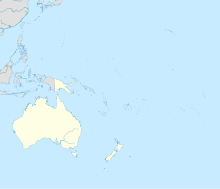Lapita
Coordinates: 21 ° 6 ′ 10 ″ S , 164 ° 47 ′ 56 ″ E
Lapita is an archaeological site on the Foué Peninsula on the west coast of the main island of Grande Terre in New Caledonia .
First discovery
As early as 1908, the German Father Otto Meyer found a few decorated pottery shards on the island of Watom in the Bismarck Archipelago and sent them to the Musée de l'Homme in Paris , where they disappeared unnoticed in a storage room. In 1920 the anthropologist William C. McKern (1892–1988) found the same pottery in Tonga, 3700 kilometers away . He had never heard of Meyer's find and made no connection.
The site Lapita (Site WKO013), as the locals called the beach, was not extensively excavated until 1947 by ornithologist and anthropologist Edward W. Gifford (1887-1959), a former McKern employee. However, he immediately recognized the connection to the earlier finds. With the then new radiocarbon dating , he determined the age of the pottery shards to be 2400 to 2800 years.
Lapita is the eponymous site for the Pacific Lapita culture . The site was discovered through surface finds of pottery with shell impressions. This pottery was already known from the islands of Watom and L'Île-des-Pins . The site was excavated in a system of squares in artificial layers. The discovery of the site was celebrated in 2002 by an international conference in Nouméa .
In 2004, during plantation work on the island of Efate (Vanuatu), a 3000 year old Lapita culture burial site with the remains of more than 60 corpses was discovered. In addition, six completely preserved clay pots from this time were found there. This is the oldest find of the Lapita culture to this day.
Lapita culture
→ Main article: Lapita culture
The Lapita culture, as Gifford called it, he attributed to the so-called "Austronesians". They set out on Taiwan and sailed across the Philippines , Indonesia and Papua New Guinea to far into the Pacific. An incomparable mass migration that took place around 3000 BC. Began and with the end of which the Pacific island world was discovered and settled.
Waga
The Lapita people had developed a type of boat they called waga . An outrigger canoe with carved bow and stern figures on the double hull, with mat sails and a large platform on which people, animals and utensils could find space. These large canoes could be up to 20 meters long.
Around 2000 BC The Lapita people try their wagas and their sailing skills in Melanesian waters. They proved to be ideal for the further development of their canoes and their sailing skills through the closely spaced islands of Melanesia. From the Bismarck Archipelago in Papua New Guinea, the Lapita people advanced to the Solomon Islands and Vanuatu . Now the open ocean was before them. The Lapita culture spread to Fiji , reached Tonga and around 1000 BC. The Samoan Islands. The connection to the old homeland was maintained for a long time. Wagas sailed between Polynesia and Melanesia laden with people and goods. The Lapita people became Polynesians.
Bronisław Malinowski spent the years 1914 to 1920 doing ethnographic research in Papua New Guinea. He documented the construction of wagas on the Trobriand Islands . The word waga stood for all types of vessels. The largest type of boat that was seaworthy, had the largest loading capacity, water displacement and the most stable construction was called masawa . Malinowski was one of the few western visitors to Melanesia who described in detail the construction of such a canoe, which took months, sometimes years (and still takes so long today): from cutting down the trees to the maiden voyage. So did Stuart Berde, an anthropologist from the United States. He spent a year on the island of Panaeati ( Deboyne Islands / Papua New Guinea) in the 1970s , researching the construction of a comparable canoe. On the same island, the writer and photographer Milda Drüke documented the construction of a seaworthy outrigger canoe for her book Solomon Blue in 2000 , which the locals call waga enona . Author David Lews describes in his classic We, the Navigators , how Polynesian sailors navigated by stars, clouds and currents.
literature
- Milda Drüke: Solomon Blue. With the islanders of Papua New Guinea. Frederkind & Thaler 2007, ISBN 978-3-89405-660-5 .
- Edward Winslow Gifford, Dick Shutler : Archaeological excavations in New Caledonia. University of California Press, Berkeley 1956.
- KR Howe: Vaka Moana, Voyages of the Ancestors: The Discovery and Settlement of the Pacific. University of Hawaii Press 2007, ISBN 978-0-8248-3213-1 .
- Ralf-Peter Märtin: Navigation. The daring journeys of the first Polynesians. In: GEO special South Sea. Gruner and Jahr, Hamburg 2000, ISBN 3-570-19058-7 .
- Roff Smith: Departure into the unknown. How sailors colonized the islands of the Pacific thousands of years ago. In: National Geographic Germany. April 2009, pp. 128-145.
- Arnaud Noury, J.-C. Galipaud: Les Lapita, nomades du Pacifique (french) . IRD Editions, France 2011.
Web links
- geoportail.fr high resolution interactive map of New Caledonia
Individual evidence
- ^ A b Christophe Sand: Lapita and non-Lapita ware during New Caledonia's first millennium of Austronesian settlement . In: Le Pacifique de 5000 à 2000 avant le présent. Supplements to the history of colonization . Institut de recherche pour le développement, Paris 1999, ISBN 2-7099-1431-X , p. 139-159 . ( Full text (PDF; 889 kB) as digitized version)
- ↑ Christophe Sand (Ed.): Pacific archeology: assessments and prospects. Department of Archeology, Service des Musées et du Patrimoine de Nouvelle-Calédonie, Nouméa 2003, ISBN 2-9519208-1-4 ( Le Cahiers de l'archélogie en Nouvelle-Calédonie. 15).
- ^ Bronisław Malinowski: Argonauts of the western Pacific. 1922.
